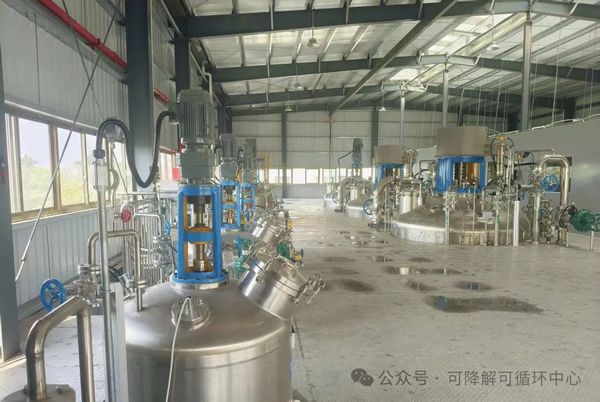Guangdong's thousand-ton PHA production line completes technical transformation, to be applied in biodegradable tableware
On March 20, Guangdong Hefeng Bio-Technology Co., Ltd. successfully completed the technical renovation of its annual production line of thousand-ton-level polyhydroxyalkanoates (PHA). The project officially succeeded in trial operation with a PHA production line featuring a 60-cubic-meter large-scale fermenter as the core fermentation unit. The first batch of PHA products passed inspection according to food contact standards and will be used for biodegradable tableware.

It is reported that PHA, due to its unique advantage of being fully biodegradable, has become an important substitute for disposable petroleum-based plastics. Since its establishment in the Suixi County Private Technology Industrial Park in 2021, Guangdong Hefeng has invested nearly 30 million yuan in the construction and upgrading of its PHA production line. At the same time, with strong support from the provincial, municipal, and county governments, it has successively received special funding from the Guangdong Provincial Key R&D Program in Green Bio-Manufacturing and the Zhanjiang Leading Plan. The PHA project has filled the industrial gap in the large-scale production of biodegradable materials in South China, forming an innovative bio-manufacturing industry model with the characteristics of the Greater Bay Area, which is down-to-earth. Currently, Guangdong Hefeng's PHA series products have been recognized by multiple downstream material application companies and are gradually advancing towards large-scale production.
This technological upgrade is based on genetically engineered bacteria with independent intellectual property rights for metabolic modification. Utilizing the company's iteratively developed high-density PHA fermentation process, and through the introduction of key technologies such as a newly designed 60-cubic-meter fermentation tank and a supporting semi-intelligent fermentation control system, the PHA fermentation cycle has been shortened by over 10%, fermentation efficiency improved by 25%, unit energy consumption reduced by 22%, production costs lowered by 18%, and annual single-tank production capacity exceeding 700 tons.
In addition, the良品率 of the current trial production batches has reached 98%, not only laying a solid industrial foundation for the subsequent construction of a 10,000-ton production line, but also accelerating the expansion of application scenarios for traditional plastic alternatives. This will help achieve China's "dual carbon" goals, and provide an effective and sustainable solution to the increasingly severe problem of microplastic pollution.
The successful trial production of PHA in the 60 cubic meter fermentation tank marks a key milestone for Guangdong Hefeng in transitioning from "laboratory research" to "Industry 4.0 intelligent manufacturing." Relevant officials from Guangdong Hefeng stated that over the next three years, the company will continue to rely on the Suixi base to gradually build a PHA material-centered industrial cluster in South China. At the same time, it will collaborate with upstream and downstream enterprises to create a PHA industrial ecosystem characterized by "raw materials - production - application," radiating across the country and Southeast Asia, and further promoting the widespread use of biomaterials. It is reported that Guangdong Hefeng plans to finalize the site selection for a 10,000-ton PHA production line by the end of 2025, with the line expected to be operational by 2027.
【Copyright and Disclaimer】The above information is collected and organized by PlastMatch. The copyright belongs to the original author. This article is reprinted for the purpose of providing more information, and it does not imply that PlastMatch endorses the views expressed in the article or guarantees its accuracy. If there are any errors in the source attribution or if your legitimate rights have been infringed, please contact us, and we will promptly correct or remove the content. If other media, websites, or individuals use the aforementioned content, they must clearly indicate the original source and origin of the work and assume legal responsibility on their own.
Most Popular
-

Brazil Imposes Five-Year Anti-Dumping Duty of Up to $1,267.74 Per Ton on Titanium Dioxide From China
-

Mexico officially imposes tariffs on 1,400 chinese products, with rates up to 50%
-

MOFCOM Spokesperson Answers Questions from Reporters on China-U.S. Kuala Lumpur Trade Consultations Joint Arrangement
-

"Golden October" Weak, Polyethylene Prices Hit New Low of the Year in October
-

Kingfa Sci & Tech Q3 Net Profit Attributable to Shareholders Rises 58.0% YoY to 479 Million Yuan






